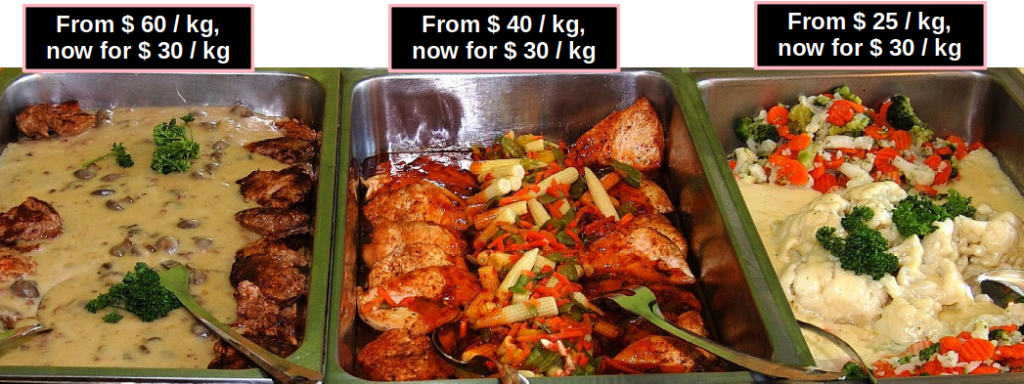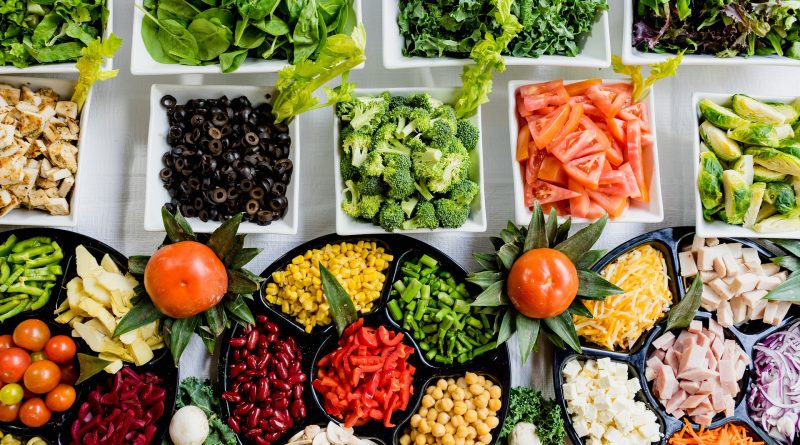How to pay ‘cheap’ in self-service restaurants
I’ve always hated restaurants self-service by the pound. I believed that the option flat rate was better, after all, you can eat as much as you want until you feel satisfied, while in the option by the pound, I put two shells of rice, a salad and a steak, which my dish is already costing a fortune.
I think a lot of people think so too, but almost a month ago I had a self-service revelation. And I realized that there really is a mathematical formula for paying more ‘cheap’ than things actually cost in those places.
Let’s think about it with a mathematical look, in the place where I was with my friend on Sundays the price of the kg was 54.90 $, so let’s call the items that I used to form my plate a1, a2, a3,…, an, where n is a Natural number, and the weight of each item in kg is represented by x1, x2, x3,…, xn. So, the value of my dish will come out:
(a1.x1 + a2.x2 + a3.x3 + a4.x4 + a5.x5)*54,90$ = 27,45$
My friend made the following dish:
(a1.x7 + a5.x8 + a6.x9 + a7.x10 + a8.x11)*54,90$ = 27,45$
In this case, some items are repeated, but the quantities vary. Apparently our dishes have the same value, but the question is, who is paying cheaper for the chosen foods?
If we assume what the value per kilo of each item on the plates would be, we arrive that:
| a1/kg = 60$ | a1/kg = 60$ |
| a2/kg = 40$ | a5/kg = 70$ |
| a3/kg = 35$ | a6/kg = 15$ |
| a4/kg = 80$ | a7/kg = 8$ |
| a5/kg = 70$ | a8/kg = 12$ |
We know that the sum of all items gave the same weight, that is, half a kilo, now replacing these values in the equations, we will have that the real cost of our dish (if it were purchased item by item) would be:
My plate: 60.x1 + 40.x2 + 35.x3 + 80.x4 + 70.x5
My friend’s dish: 60.x7 + 70.x8 + 15.x9 + 8.x10 + 12.x11
Note that x1 + x2 + x3 + x4 + x5 + x6 = 0.5 = x7 + x8 + x9 + x10 + x11 + x12, all real numbers greater than 0. With this, my plate will come out ‘cheaper’ than the restaurant charges per kg if:
60.x1 + 40.x2 + 35.x3 + 80.x4 + 70.x5> 27.45
With that, my friend’s dish will come out ‘cheaper’ than the restaurant charges per kg if:
60.x7 + 70.x8 + 15.x9 + 8.x10 + 12.x11> 27.45
In this logic, see that if all the chosen items had their values per kilo greater than the price of the restaurant ($ 54.90), then for any quantity chosen, we would always be paying ‘cheaper’, for example, a dish formed by a1 , a4 and a5, with quantities x12, x13, x14.
Hypothetical plate always cheap: a1.x12 + a4.x13 + a5.x14> 27.45 for any x12, x13 and x14> 0.
On the other hand, a dish made up only of items whose values per kilo are less than the price of the restaurant ($ 54.90), so for any quantity chosen, we would always be paying more ‘expensive’, for example, a dish made up of a2 , a3, a6, a7 and a8, with quantities x15, x16, x17, x18 and x19.
Hypothetical plate always expensive: a2.x15 + a3.x16 + a6.x17 + a7.x18 + a8.x19 <27.45 for any x15, x16, x17, x18 and x19> 0.
In intermediate contexts, in which some items per kilo would cost more than $ 54.90 and others less (as in the situation with me and my friend), the quantity of each item will influence whether the total value of the dish will come out ‘cheap’ or ‘expensive’ . For example, if we both take 100 grams of each item, we have:
Actual cost of my dish: 6 + 4 + 3.5 + 8 + 7 = $ 28.5
Actual cost of my friend’s dish: 6 + 7 + 1.5 + 0.8 + 1.2 = $ 16.5
In this context, my dish is already coming out cheaper than it is worth, while my friend’s is coming out more expensive. To fix this, he would need to invest more in a1 and a5, and less in a6, a7 and a8.
In a new formulation, assuming it takes 110 grams of a1, 300 grams of a5, and 30 grams of a6, a7 and a8, your plate would come out:
6.60 + 21 + 0.45 + 0.24 + 0.36 = $ 28.65
The situation improved, although the other items are still weighing against, the fact of investing in items a1 and a5 allowed your dish to be more ‘cheap’ than the products would cost.
In a simpler way to understand this reasoning, if hypothetically two people make dishes 100 grams each. One only sweet potato and the other only with salmon. Both will be paying $ 5.49 for their products, the difference being that 100 grams of sweet potatoes for that amount is ‘expensive’, while 100 grams of salmon for that amount is ‘cheap’.
Would your choices of dishes in these restaurants be the same if you had on top of each greenhouse how much this product would come out per kilo? Maybe an ‘artichoke heart’ whose kilo is 270 $ doesn’t start to taste any better than a serving of french fries whose kilo is 15 $?

Credits for the cover image Mark Wilson from Pixabay

